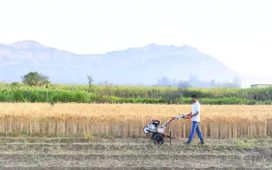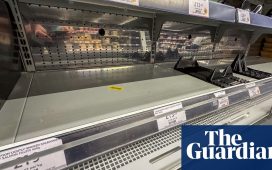Travelers using Newark Airport’s new $2.7 billion Terminal A are among the first to encounter the future of airport security screening – from barrel-shaped 3-D baggage screening machines that use the same technology in a MRI, to more passenger-friendly open air full body scanners.
NJ Advance Media recently got a behind the scenes at how the new equipment screens passengers and carry-on bags faster, more efficiently and most importantly, more effectively.
Of the 16 Transportation Security Administration screening lanes at Newark Airport’s new Terminal A, 14 use the new tomography scanners that take a three-dimensional image of carry-on baggage, which is meticulously scrutinized by TSA officers working in a separate office.
“It is the latest and greatest in technology,” said Thomas Carter, TSA New Jersey federal security director. “The new tomography system is like a CT scan for your property.”
The remaining two lanes use “legacy” X-ray scanning equipment similar to what is used in other terminals, to be used for bulky items that can’t fit in a plastic bin.
The new 3-D scanners are twinned with a “next generation walk through” full body scanners.
These open air, Advanced Imaging Technology body scanners no longer require travelers to get inside a plastic booth and raise their hands over their heads, which Carter said makes screening easier for travelers with balance and mobility issues. Instead, passengers can keep their arms down, but away from their body for screening.
“They’re more customer friendly and not as claustrophobic,” Carter said. “The detection capability is tremendously enhanced.”
The difference could be seen when a traveler with mobility issues was able to walk in to one of the new body scanners in Terminal A with more ease than if they had to use on older model scanner.
The scanners also detect metallic and non-metallic items a person might have, including underwear bombs and guns made of non-metallic components, Carter said. However, they won’t be triggered by metal internal to the body, such as hip replacements or metal rods, said Lisa Farbstein, a TSA spokesperson.
The new 3-D baggage scanners also have been deployed at Trenton-Mercer and at Atlantic City Airports, Carter said. Funding from Congress will dictate when that equipment is purchases and deployed.
Costs to equip Terminal A with the new equipment were not available because the TSA makes bulk purchases for airports across the country, Farbsten said. Some airport operators also purchase screening equipment from TSA approved vendors, which the Port Authority of New York and New Jersey did for Terminal A, she said.
Port Authority officials were not able to provide a cost for Terminal A screening equipment it purchased.
A noticeable change is the 3-D tomographic scanners no longer require an officer at that station reading an X-ray scanner. Instead, officers stationed in a library-like quiet screening center examine the images on computer screens and decide if something warrants further examination.
“It provides efficiency. Officers can focus,” Carter said. “Officers work as a team to review images.”
This is where the detail provided by 3-D scanning comes in.
Officers can rotate the image of scanned bags with their fingertip on a computer screen and move them to look at any angle. They can further use the CT technology to break the image down to slices of what’s inside a bag, a bin or even a laptop.
Officers send suspect images to a supervisor who examines the image and can clear the bag or flag it for manual inspection. On the screening line, a flagged bag gets automatically sent down a different conveyor to a station for further screening and investigation.
At that station, a TSA officer has super sensitive explosive trace detection system that can be used to swab bags.
“If you dissected a single grain of sugar 200 times, this can pick it up,” Carter said.
Other equipment can scan bottles of liquids for hazardous materials, he said.
Deploying the new equipment has come with some hiccups that resulted in lines and delays earlier this month. Most of those delays were attributed to newly trained staff becoming more familiar and comfortable using the new equipment, Carter said. He compared it to a driver of an old car becoming acclimated to driving a modern vehicle and learning how to operate all the functions.
TSA added 66 new officers in Terminal A, 27 after Martin Luther King Day and 39 more later in January, he said.
“They’re still not experts,” he said. “There are still things to work out. It’s a new environment and new technology.”
Another 120 TSA officers are expected to join the workforce in May with “many” going to Newark Airport, Carter said.
“We have the capacity to run up to 12 lanes in the terminal,” Carter said, saying until more staff are added, there could be delays during peak travel days. Between eight and nine lanes are in use during days with normal travel volume.
Carter said they are using overtime to keep additional lanes open during those times, and the screening process is getting faster as staff gains experience.
“It’s culture change, doing more with fewer lanes, ” Carter said. “We maintain a reasonable wait by putting more people in the screening room. … We have our standard days down pat. It’s peak days – we are getting more (experience) under our belt.”
So what’s an optimum wait time? “I get alerts when wait times hit 15 minutes, we don’t want people waiting. We adjust the lanes and staff, the goal is to keep it as low as possible,” Carter said.
Even with the new technology, the TSA’s standard advice is to still get to the airport at least two hours before flight time, to allow extra time for parking, check in and screening, Farbstein said.
What’s different for travelers?
The changes start with the lowly gray plastic bin travelers load with baggage and items. Each bin has an electronic RFID tag for easy identification and tracking through the entire process. The next change are four “divesting stations,” where individual passengers can load their bags and belongs into bins for screening. Additional bins are below the station.
The individual stations help reduce passenger traffic jams if one individual has more items to load in bins, Carter said. Digital cameras also help track the processes.
What’s not here? Footwear scanners used in some foreign airports that allow security screeners to check for threats. TSA officials deem it more effective to detect threats by having passengers take off shoes and boots and send them through the tomographic scanner.
“We can get a 3-D image of them,” he said.
The new equipment also relieves TSA officers of some labor intensive manual tasks, such as carrying empty bids to the front of the checkpoint.
Even leaving the airport has been made more secure with sets of automatic doors that prevent passengers from returning to the secured area of the terminal, Carter said. Other terminals have no barrier to prevent passengers from turning around, instead relying on a TSA officer standing by. This frees up officers for more critical duties, he said.
Please subscribe now and support the local journalism YOU rely on and trust.
Larry Higgs may be reached at lhiggs@njadvancemedia.com.











